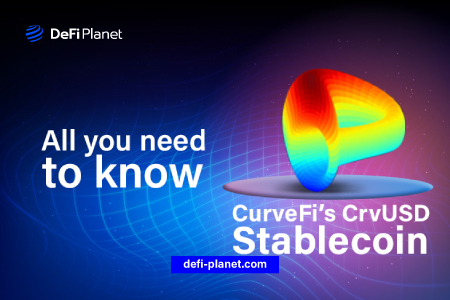Last updated on June 9th, 2023 at 12:02 pm
Introduction
Stablecoins, with a market valued at an impressive $130 billion, have become a vital tool in DeFi to safeguard against market volatility and the risks of traditional finance. However, most stablecoins available today are centralized and prone to bankruptcy. Thus, users of these digital assets are still vulnerable to the same problems they were created to avoid.

Amid these intriguing market dynamics, Curve Finance’s crvUSD stablecoin has emerged as an innovative solution. Unlike its centralized counterparts, crvUSD is backed by cryptocurrency and implements a groundbreaking lending-liquidating AMM algorithm.
This unique approach ensures capital efficiency, mitigates liquidation risks, and positions crvUSD as the first genuine stablecoin.
However, the question remains: Can it effectively compete with established stablecoins and win the trust of DeFi users?
This article comprehensively explores the crvUSD stablecoin, how it works, and its prospect for success in the DeFi ecosystem.
To get started, let’s do a quick priming on stablecoins.
What is Stablecoin?
A stablecoin is simply a cryptocurrency designed to maintain a fixed value, usually by being pegged to an asset like a fiat currency or another cryptocurrency. This means that the stablecoin’s value is always equal to the value of the underlying asset on a one-to-one (1:1) basis. DeFi users use stablecoins to limit their exposure to risks and avoid the volatility of the crypto market.
The most popular DeFi stablecoins (USDC, USDT, and others) are backed by the US dollar, but there are other types of stablecoins backed by different assets. For example, the DAI stablecoin is backed by Ethereum (ETH).
A Brief Overview of Curve Finance’s New Offering: crvUSD Stablecoin
Curve Finance (CurveFi) is a prominent player in the DeFi industry, enjoying substantial popularity among DeFi enthusiasts.
According to defillama, Curve Finance currently holds the highest total value locked (TVL) among decentralized exchanges (DEX), with $4.28 billion worth of assets locked within its ecosystem. However, it’s important to note that this TVL represents a significant drop from its previous figure of $20 billion, primarily due to the de-pegging of Terra’s UST stablecoin.

What sets Curve Finance apart is its focus on facilitating the trading of similar assets and stablecoins, which carries less risk compared to trading volatile assets like UNI/ETH or volatile assets against stablecoins like ETH/USDT on other popular DEX platforms.
The protocol charges only a nominal fee due to its composability and offers lower earnings for liquidity providers. These features make Curve Finance an appealing choice for risk-averse DeFi users seeking to maximize their capital.
Curve Finance also employs liquidity farming activities and other strategies to make the protocol more attractive, incentivize liquidity providers, and attract more users.
What is crvUSD?
crvUSD is CurveFi’s native stablecoin. Similar to other stablecoins, it’s backed by an underlying asset, ETH, in this case. crvUSD is used in a collateralized debt position (CDP), meaning that crvUSD is overcollateralized and has little exposure to liquidation risk.
Curve Finance announced the development of its stablecoin in 2022 and subsequently released a whitepaper for the stablecoin in the same year. On May 3, 2023, Curve Finance launched the crvUSD smart contract on the Ethereum network.
In a significant move, CurveFi’s CEO, Michael Egorov, deposited 957 sfrxETH (a type of ETH created by Frax) valued at $1.8 million to mint $1 million crvUSD. Currently, there are only 20 million crvUSD in supply.
DeFi users have the option to deposit sfrxETH as collateral to mint new crvUSD stablecoins. It’s important to note that crvUSD is not a governance token and does not grant voting rights on CurveFi’s proposals. Decisions are made on CurveFi protocol using the CRV token–its other native token. CRV allows the CurveFi community to vote on protocol fees, rewards, and development decisions. The token is also used for yield farming activities.
How crvUSD Works
crvUSD is currently accessible through a smart contract on the Ethereum network, primarily catering to users with technical knowledge in DeFi. While an interface for end-users is yet to be developed, crvUSD on the Ethereum network is expected to support collateral deposits of ETH for minting new crvUSD tokens.
crvUSD uses a mint-and-burn mechanism to create new crvUSD to manage its supply in relation to its collateral. When a DeFi user wants to borrow crvUSD, they need to deposit collateral which is locked in a smart contract. Then, a new crvUSD is minted (created) and given to the borrower. If the borrower repays the borrowed crvUSD, it gets burned (taken out of circulation), and the collateral is unlocked.
crvUSD has no maximum supply like other traditional cryptocurrencies. The total amount of crvUSD in circulation depends on the amount of collateral locked up in the smart contract.
The crvUSD stablecoin boasts two significant features that distinguish it from other stablecoins in the DeFi industry. In the following sections, we will delve into these features to gain a deeper understanding.
1. Lending-Liquidity Automated Market-Making Algorithm (LLAMMA)
Curve stablecoin’s whitepaper states that crvUSD is based on a lending-liquidity automated market-making algorithm. This unique concept enables collateral rebalancing within the crvUSD smart contract without resorting to direct asset liquidation, a capability not present in current stablecoin protocols.
Traditional DeFi lending protocols require collateral as security when a user borrows stablecoins. They set a collateralization ratio to ensure sufficient coverage for the borrowed amount. If the value of the collateral falls below this ratio, the protocol may liquidate the collateral, leaving the borrower with less stablecoin than the collateral’s value. However, crvUSD’s LLAMMA mechanism provides a solution to this problem.
Rather than liquidating collateral in one go, the system progressively converts a portion of the collateral into crvUSD. This means that when the collateral reaches the liquidation level, the borrower may possess more value in crvUSD than if their collateral had been liquidated at once.
However, if the collateral’s price starts to rise again, the crvUSD is automatically used to repurchase the collateral according to the smart contract rules. This fully automated process mitigates the risk of losing all collateral in the event of liquidation.
LLAMMA’s rebalancing model also reduces a borrower’s exposure to volatility. In the event of a sharp price drop, this model would have converted some of the borrower’s funds into crvUSD and limit their potential losses.
crvUSD’s LLAMMA design offers superior capital efficiency compared to other stablecoins and lending protocols. Instead of locking collateral in an idle position, the crvUSD design enables the collateral to be utilized in CurveFi’s liquidity pools, generating additional yield. This effectively puts idle capital to work.
2. Peg Keeping
Peg-keeping is how crvUSD keeps its price (peg) stable at $1. This process works similarly to the concept that powers algorithmic stablecoins. The developers maintain a special reserve via a peg-keeping contract that can be used to create new crvUSD tokens without needing collateral.
This new supply helps balance the demand and keeps the price at $1, and when the demand for crvUSD rises exponentially, its price may exceed $1. Conversely, if the price falls below $1, the reserve can be used to destroy (burn) some crvUSD tokens, reducing supply and restoring the price to $1.
It is important to note that the crvUSD tokens minted or burned by the reserve are not released into circulation. Their purpose is solely to stabilize the price of crvUSD at $1.
Benefits of Using crvUSD
crvUSD brings several advantages to users in the decentralized finance (DeFi) ecosystem. Let’s explore its key benefits:
Capital Efficiency
The crvUSD smart contract allows the ‘idle funds’ to be locked into Curve pools, thus, earning the user additional rewards. By depositing funds into these pools, the crvUSD pools become more liquid and able to facilitate a variety of trades and yield-generating activities.
Risk Reduction
CurveFi’s crvUSD rebalancing design mitigates the risk of complete liquidation for borrowers. The system progressively converts collateral into crvUSD as the price drops and automatically buys back the collateral when the price recovers. This mechanism safeguards borrowers from losing all their collateral and provides extra crvUSD to offset their position during default.
High Volatility Hedge
The crvUSD rebalancing design also minimizes a borrower’s exposure to volatility. As the LLAMMA rebalancing mechanism progressively liquidates collaterals, it helps smoothen out sudden price fluctuations inherent in the crypto market.
Overcollateralization
Curve Finance ensures crvUSD’s stability by overcollateralizing the stablecoin. This means that even when borrowers default, the pegged value of crvUSD to $1 remains intact.
Decentralization
Compared to the top three stablecoins (USDT, USDC, & BUSD), crvUSD operates in a more decentralized manner. crvUSD is backed by cryptocurrencies and is free from centralized control. It offers DeFi users a decentralized stablecoin alternative.
Yield Farming Opportunities
DeFi users can lock their crypto tokens and borrow crvUSD to participate in yield farming activities, maximize returns and still keep their collateral intact through crvUSD’s rebalancing. Additionally, CurveFi provides extra incentives for yield farmers, such as generating additional fees from the collateral deposited and traded in Curve pools.
Potential Risks Of the crvUSD
While crvUSD offers promising features, it’s important to be aware of the potential risks associated with this innovative stablecoin:
Technological Risk.
As a new type of stablecoin, the real-world use of crvUSD carries a degree of uncertainty. Although CurveFi has conducted stress tests in simulations, there is still a possibility that its implementation may encounter challenges or may not perfectly align with real-world requirements.
Smart Contract Vulnerability
crvUSD’s value is backed by cryptocurrencies held in its smart contract. Even with audits, smart contracts are not immune to bugs or vulnerabilities, especially more updates are integrated into them. If malicious actors exploit a vulnerability in the crvUSD smart contract, users with funds locked in it could be at risk of losing their assets. This could potentially create a domino effect that will result in a de-peg of the crvUSD as it becomes backed by nothing.
Regulatory Uncertainty
Like other DeFi stablecoins, crvUSD may face regulatory hurdles and uncertainties. If regulations or government policies become unfavorable towards stablecoins in the future, holding and utilizing crvUSD could become more challenging. This regulatory risk may affect the ability to use or trade the stablecoin in compliance with evolving regulations.
Future Outlook of the crvUSD Stablecoin

The crvUSD stablecoin holds significant potential for growth and success in the DeFi industry. If it lives up to its high standards, crvUSD can potentially become the holy grail of decentralized stablecoins in the long run. However, since it is a new type of stablecoin, there exists a possibility that it may fall short of its own lofty expectations.
In such a scenario, it will be important for the CurveFi team to quickly adjust crvUSD to fit market needs and ensure its continued success. Fortunately, CurveFi has years of experience in the finance industry, which can come in handy in improving the overall outlook and performance of crvUSD.
Ultimately, the success of crvUSD will depend on various factors, such as CurveFi’s implementation of the stablecoin, the response of the DeFi community, and cryptocurrency regulations worldwide. These factors have the potential to shape the future trajectory of crvUSD.
In Conclusion,
- CurveFi’s crvUSD stablecoin presents a compelling value proposition in the DeFi market as a decentralized stablecoin.
- It offers several advantages that DeFi users can leverage, including improved capital efficiency, reduced risks, and protection against volatility.
- One particularly appealing aspect is its innovative rebalancing structure, which effectively minimizes the risk of liquidation and benefits both borrowers and the CurveFi protocol.
- However, despite its potential as a decentralized stablecoin, crvUSD will face competition from more established stablecoins like USDT and upcoming contenders such as Aave‘s GHO stablecoin.
- Keeping an eye on how crvUSD navigates this competition is an interesting event to look forward to.
- It will be fascinating to see how crvUSD navigates this competition, and DeFi enthusiasts will be keeping a close watch on its performance.
Disclaimer: This article is intended solely for informational purposes and should not be considered trading or investment advice. Nothing herein should be construed as financial, legal, or tax advice. Trading or investing in cryptocurrencies carries a considerable risk of financial loss. Always conduct due diligence.
If you would like to read more articles like this, visit DeFi Planet and follow us on Twitter, LinkedIn, Facebook, Instagram, and CoinMarketCap Community.
“Take control of your crypto portfolio with MARKETS PRO, DeFi Planet’s suite of analytics tools.”





















